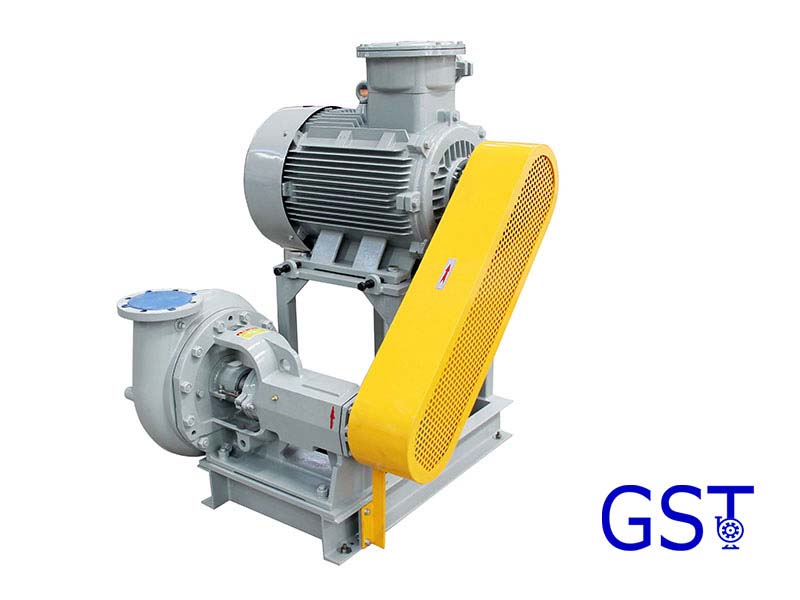Что такое насос для перекачки бурового раствора?
Aug 14, 2025
A насос для бурового раствора Это высокосдвиговое перемешивающее устройство, специально разработанное для обработки бурового раствора. Оно измельчает и диспергирует твердые частицы в буровом растворе посредством механических сил (сдвига, удара и турбулентности), способствуя полному растворению добавок, таких как полимеры и глины. В конечном итоге достигается гомогенизация бурового раствора, оптимизация его реологических свойств и повышение производительности.Ⅰ. Основные функцииИзмельчите крупные твердые частицы в буровом растворе (например, шлам, недиспергированную глину), чтобы уменьшить агломерацию частиц.Ускорьте растворение и активацию химических добавок, таких как полимеры, понизители водоотдачи и загустители.Улучшить вязкость, усилие сдвига и реологические свойства бурового раствора, усилив его способность удерживать шлам, препятствовать обрушению ствола скважины и охлаждать буровое долото.Поддерживать стабильность системы промывки, обеспечивая эффективный вынос шлама, балансировку давления в скважине и смазку бурильной колонны во время циркуляции.Ⅱ. Принцип работыОсновной принцип работы насоса для перекачки бурового раствора заключается в создании интенсивных сдвигающих усилий и гидродинамических эффектов посредством высокоскоростного относительного движения ротора и статора. Конкретный процесс заключается в следующем:1.Срезное действие: Между ротором (высокоскоростным вращающимся компонентом) и статором (неподвижным компонентом) имеется небольшой зазор (зазор сдвига, обычно 0,1–1 мм). Проходя через этот зазор, буровой раствор «срезается» высокоскоростным вращающимся ротором, разрывая крупные частицы на более мелкие.2.Удар и турбулентность: Высокоскоростное вращение лопастей ротора создаёт в шламе интенсивную турбулентность и вихри. Высокочастотные соударения возникают между частицами, а также между частицами и лопастями, что приводит к их дальнейшему дроблению и диспергированию примесей.3.Смешивание и гомогенизация: Под совместным воздействием сдвига и турбулентности твердые частицы, жидкости и добавки в буровом растворе полностью перемешиваются, образуя однородную и стабильную систему, предотвращающую расслоение или седиментацию.Ⅲ. Структурный составКонструкция насоса для перекачки бурового раствора разработана с учётом таких требований, как высокая эффективность сдвига, износостойкость и адаптация к тяжёлым условиям эксплуатации. Он состоит из следующих основных компонентов:1. Система силового приводаИсточник привода: Обычно взрывозащищенный двигатель (для наземного бурения) или гидравлический двигатель (для морского бурения, адаптировано к условиям высокой вибрации), обеспечивает вращательную мощность. Диапазон мощности варьируется от десятков до сотен киловатт в зависимости от производительности.Редуктор/передающее устройство: Передает мощность на ротор через муфты, редукторы и т. д. и регулирует скорость ротора (обычно 1000–3000 об/мин; более высокие скорости повышают эффективность сдвига).2. Основные рабочие компоненты: ротор и статорРотор: «Активный элемент» насоса сдвига, обычно цилиндрический, со спиральными лопастями или зубчатыми выступами на поверхности. Материалы лопастей должны быть износостойкими (например, высокохромистый чугун, покрытие из карбида вольфрама), чтобы выдерживать абразивное воздействие твёрдых частиц бурового раствора.Статор: «Пассивный компонент», закреплённый в корпусе насоса и соосно установленный с ротором. Его внутренняя стенка имеет пазы или каналы, соответствующие лопаткам ротора. Зазор между ротором и статором можно регулировать, изменяя конструктивные параметры; меньший зазор увеличивает сдвиговое усилие (но следует избегать риска заклинивания).3. Система жидкостных каналовВход: Подключается к цистернам с буровым раствором или циркуляционным трубопроводам, по которым буровой раствор засасывается в камеру сдвига насосом или внешней силой.Камера сдвига: Пространство между ротором и статором, служащее активной зоной, где грязь подвергается сдвигу и ударам.Выход: Через него очищенная гомогенизированная грязь выводится обратно в систему циркуляции или поступает на следующий этап обработки.Структура руководства по потоку: Некоторые сдвиговые насосы оснащены встроенными направляющими пластинами или спиральными каналами для направления осевого потока бурового раствора, что позволяет избежать локального застоя и улучшить однородность смешивания.4. Вспомогательные и защитные системыУплотнительное устройство: Использует механические уплотнения или сальниковые уплотнения для предотвращения утечки бурового раствора (особенно под высоким давлением) и защиты приводной системы от загрязнения буровым раствором.Система охлаждения: В насосах высокой мощности водяное или воздушное охлаждение снижает рабочую температуру ротора и статора, предотвращая старение материала, вызванное теплом трения.5. Система управленияОснащенный преобразователями частоты, датчиками давления, расходомерами и т. д., он может в режиме реального времени регулировать скорость, контролировать давление и расход на входе/выходе, а также адаптироваться к потребностям обработки различных типов бурового раствора (например, бурового раствора на водной основе, бурового раствора на масляной основе).4. Основные технические характеристикиВысокая эффективность сдвига: За счет оптимизации структур ротора и статора (например, многогруппового зубчатого зацепления, ступенчатых сдвиговых зазоров) эффективность измельчения частиц превышает 90%, а скорость дисперсии присадки увеличивается на 30–50%.Износостойкая конструкция: В ключевых компонентах используются износостойкие сплавы (например, Cr12MoV), резиновые футеровки или керамические покрытия для продления срока службы (при бурении абразивных пластов срок службы может быть в 2–3 раза больше, чем у традиционных насосов).Сильная приспособляемость: Способен работать с высоковязкими буровыми растворами с высоким содержанием песка (содержание песка ≤15%) и совместим с буровыми растворами на водной, масляной и синтетической основе.Стабильная непрерывная работа: Рассчитан на непрерывный режим работы с широким диапазоном производительности обработки (от 10 м³/ч до 500 м³/ч), что отвечает потребностям бурения различных масштабов (например, неглубоких скважин, глубоких скважин, горизонтальных скважин).Ⅴ. Сценарии применения и важностьСдвиговые насосы для бурового раствора широко используются при бурении нефтяных и газовых скважин, разработке сланцевого газа, геологоразведке и т. д., в том числе в следующих конкретных сценариях:1. Этап приготовления бурового раствораВ ёмкостях для бурового раствора сдвиговые насосы смешивают бентонит, глину и другие базовые материалы с водой, добавляя полимеры (например, полиакриламид), понизители водоотдачи (например, КМЦ) и другие добавки. Сдвиг обеспечивает полное растворение добавок, исключая образование нерастворенных полимерных комков, и обеспечивает получение качественного исходного бурового раствора для бурения.2. Процесс циркуляции бурового раствораВо время бурения возвращаемый буровой раствор содержит большое количество шлама и обломков бурового раствора. Срезающие насосы могут измельчать крупный шлам, предотвращая его оседание в ёмкостях для бурового раствора; при бурении скважин срезающие насосы быстро восстанавливают вязкость и суспензионную способность бурового раствора, поддерживая стабильную циркуляцию.3. Регенерация деградировавшей грязиДля бурового раствора, характеристики которого ухудшились из-за длительной циркуляции (например, из-за пониженной вязкости, плохой суспензии), сдвиговые насосы могут повторно диспергировать частицы и реактивировать добавки посредством повторного сдвига, реализуя регенерацию бурового раствора, уменьшая сброс отходов и снижая затраты на приготовление нового бурового раствора.4. Специальные требования к технологии буренияВ сложных типах скважин, таких как наклонно-направленные и горизонтальные, к буровому раствору предъявляются более высокие требования по реологии (например, низкая вязкость, высокая способность переносить шлам). Сдвиговые насосы позволяют оптимизировать реологические параметры бурового раствора за счёт точного управления интенсивностью сдвига, обеспечивая контроль траектории ствола скважины и эффективность переноса шлама.Ⅵ. Рекомендации по выбору и обслуживанию1. Ключевые параметры выбораСкорость потока обработки: определяется объемом циркуляции бурового раствора, обычно в 1,2–1,5 раза превышающим рабочий объем бурового насоса.Интенсивность сдвига: выберите структуру ротора-статора в зависимости от типа бурового раствора (например, высокая интенсивность сдвига для мелкодисперсного бурового раствора, сильное дробление для крупнодисперсного бурового раствора).Рабочее давление: адаптируйтесь к давлению в системе циркуляции бурового раствора (обычно 0,5–2 МПа), чтобы избежать перегрузки.Коррозионная стойкость: для бурового раствора на масляной основе или бурового раствора, содержащего химические добавки, требуются материалы, устойчивые к кислотам и щелочам (например, нержавеющая сталь 316).2. Ежедневное обслуживаниеРегулярно проверяйте износ ротора и статора; заменяйте их, если зазор превышает 50% от первоначального значения, чтобы предотвратить снижение эффективности сдвига.Очистите входной фильтр, чтобы предотвратить засорение или повреждение компонентов из-за попадания крупных загрязнений в камеру сдвига.Проверьте герметичность уплотнительных устройств и своевременно заменяйте уплотнения, чтобы защитить приводную систему.Регулярно смазывайте компоненты трансмиссии, чтобы обеспечить стабильную работу и снизить потребление энергии.Ⅶ. ЗаключениеСдвиговые насосы для бурового раствора обеспечивают гомогенизацию бурового раствора и оптимизируют его производительность за счёт высоких сдвиговых усилий, выступая в качестве основного оборудования, обеспечивающего приготовление, циркуляцию и регенерацию бурового раствора. Их передовая конструкция, рациональный выбор и стандартизированное техническое обслуживание напрямую влияют на эффективность бурения, безопасность скважин и контроль затрат. По мере продвижения нефтегазоразведки в глубокие и сложные пласты эффективные, износостойкие и интеллектуальные технологии сдвиговых насосов станут ключевым фактором повышения конкурентоспособности буровой техники.
ЧИТАТЬ ДАЛЕЕ





 Language :
Language : Русский
Русский English
English عربي
عربي
 Получить предложение
Получить предложение




 IPv6 ПОДДЕРЖИВАЕТСЯ СЕТЬЮ
IPv6 ПОДДЕРЖИВАЕТСЯ СЕТЬЮ
